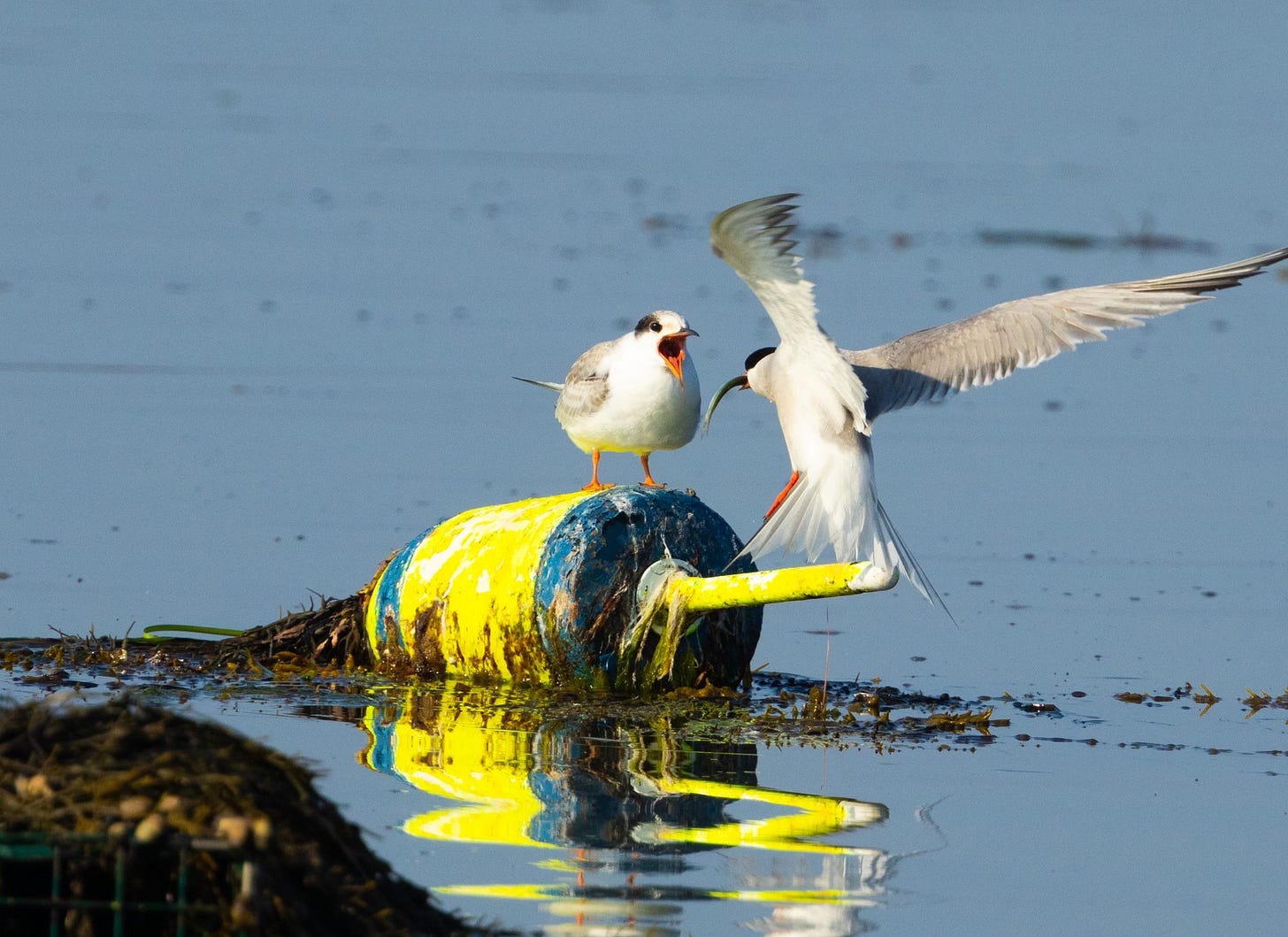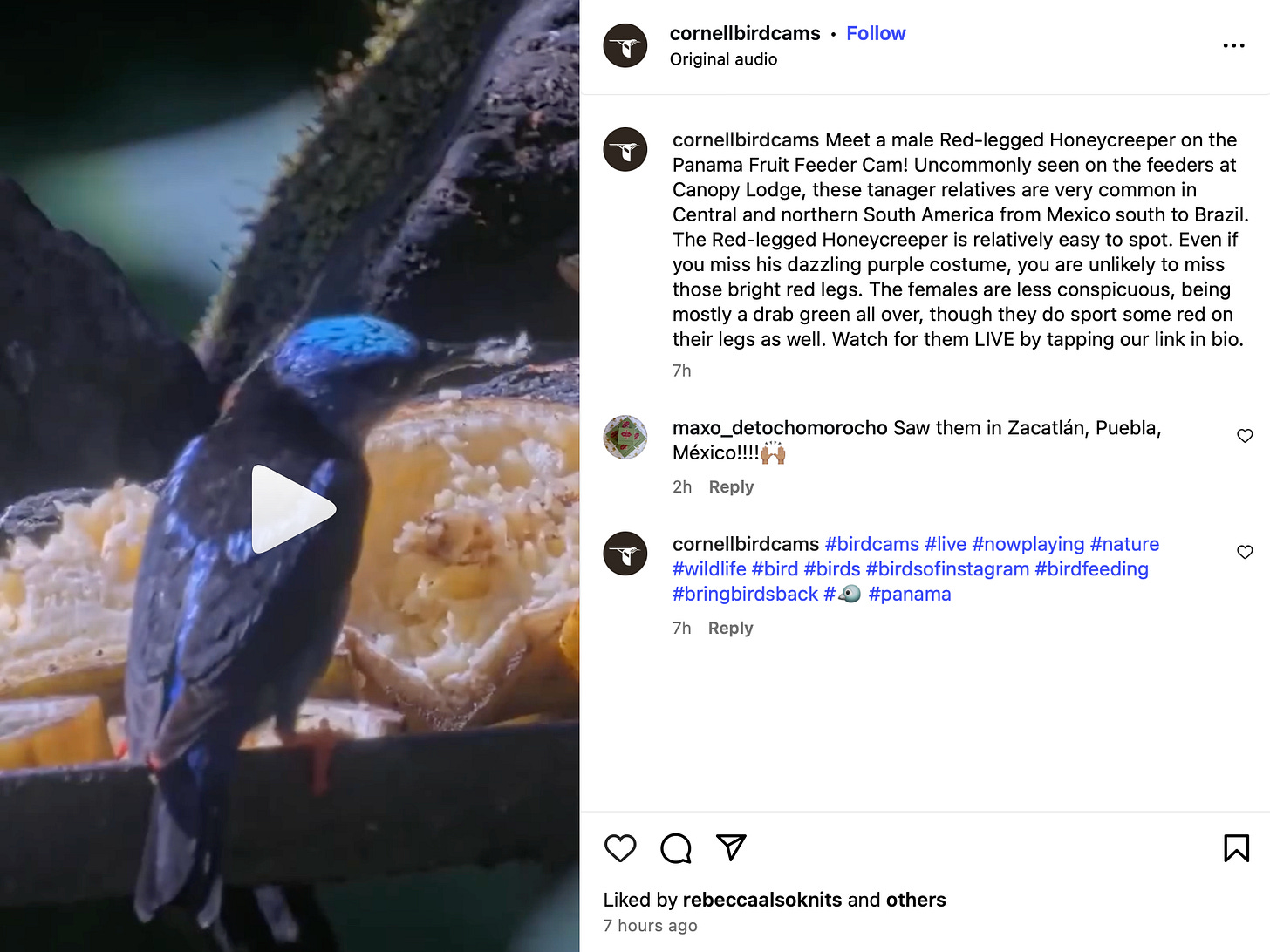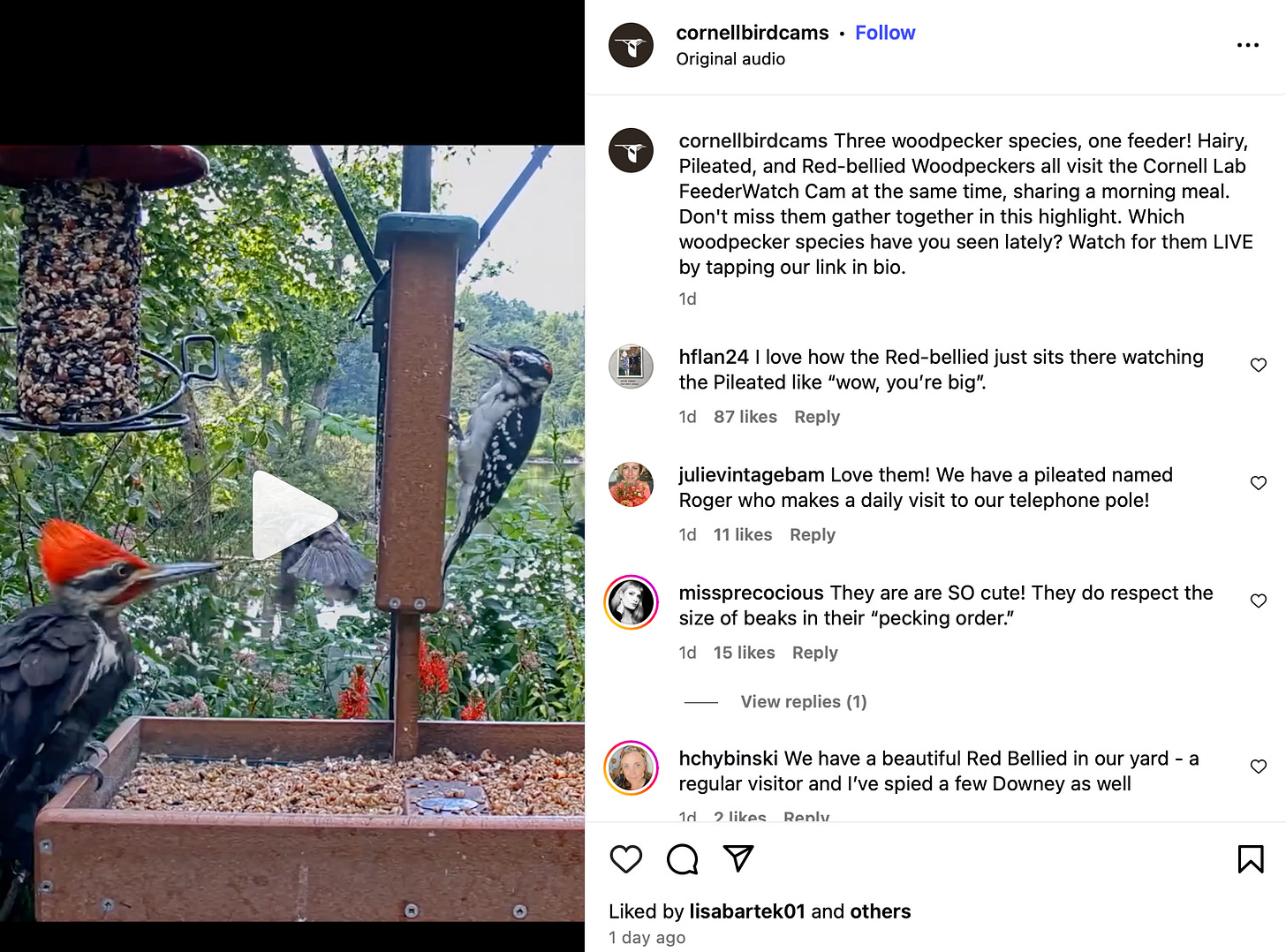Tech for Birds.
Bird News Items
1. Let's begin with a Google Deep Mind's view of how AI is advancing the critical science of bioacoustics: One of the ways scientists protect the health of our planet’s wild ecosystems is by using microphones (or underwater hydrophones) to collect vast amounts of audio dense with vocalizations from birds, frogs, insects, whales, fish and more. These recordings can tell us a lot about the animals present in a given area, along with other clues about the health of that ecosystem. Making sense of so much data, however, remains a massive undertaking. This past week, Google DeepMind released an update to Perch, their AI model designed to help conservationists analyze bioacoustic data. (via Google DeepMind)
2. A rare SCOTUS- related story, and a good one, as any reader who lives in Washington, D.C., would appreciate: About 70 years ago, Supreme Court Justice William O. Douglas helped preserve an important recreational and environmental landmark, the Chesapeake & Ohio Canal National Historical Park. And he did so not with a judicial ruling that cited a precedent, but with a letter to the editor of the Washington Post that invoked “the whistling wings of ducks.” In January 1954, the Post, in a newspaper editorial, had given its coveted endorsement to a government proposal to turn an abandoned canal site that stretches from Cumberland, Maryland, to Washington, D.C.—known colloquially as the C&O Canal—into a 60 mph highway. In its endorsement, headlined “Potomac Parkway,” the Post tapped into the post-World War II era’s go-go enthusiasm for highway construction, comparing the project to the “magnificent” Blue Ridge Parkway in Virginia and North Carolina: “The purpose of such a parkway would be to open up the greatest scenic asset in this area—the Potomac River—to wider public enjoyment.” (via Living Bird Magazine)
By Hap Ellis, Common Terns - Cape Porpoise Harbor, ME.
3. An interesting article on Malaysia's Teluk Air Tawar-Kuala Muda (TAT-KM) mudflats - mudflats of global importance: The tide is rising. On the Teluk Air Tawar-Kuala Muda coast (TAT-KM) of Penang state in Peninsular Malaysia, fishers are boating out to the sea for their morning catch. From afar, small brownish birds walk on the mudflat outside the mangrove-lined coast. When a boat gets closer, a flock of about 100 birds soars at once, swirls in unison, and lands farther away. It’s early July when Mongabay visits, the quieter time of the year in the TAT-KM mudflat. Come December, this mudflat will turn into a crowded pit stop for the birds. More than 12,000 migratory shorebirds — common redshanks (Tringa totanus), bar-tailed godwits (Limosa lapponica), Asian dowitchers (Limnodromus semipalmatus) — from Siberia and Alaska, about 10,000 kilometers (6,200 miles) away, will rest and feed there. (via Mongabay)
4. A new study on the steep decline in grassland birds in India: A new study published in the journal Global Change Biology reveals that colonial-era landscape modifications have resulted in a devastating 80% loss of grassland habitat and significant declines in grassland bird populations in India’s Nilgiri hills over the past 170 years. An international research team—led by scientists from Columbia University, the K. Lisa Yang Center for Conservation Bioacoustics at the Cornell Lab of Ornithology, Indian Institute of Science Education and Research Tirupati, and 10 other institutions—analyzed an extensive dataset comparing historical land cover maps from 1848 with modern satellite imagery and bird observations from 1850 to 2021. (via CornellLab)
5. Who knew? (Well, ornithologists have known all along): As a self-professed nature nerd, I’ve become accustomed to common names for plants being misleading. Rose of Sharon, for instance, is not a rose but a hibiscus. It follows that names for animals may also be deceiving. Nonetheless, I found myself caught off guard recently when a viral video on Instagram handed down a shocking revelation—American robins and European robins are totally different birds. They’re not even in the same family! Digital creator SarahMakesMeLaugh dropped this bombshell in hilarious fashion. “This belongs in a Disney film,” she says in the video, showing a picture of the smaller European robin (Erithacus rubecula), which is a much beloved bird in British gardens, and “in comparison this is Jeff and he changes my oil,” referring to a photo of the larger, studier-looking American robin (Turdus migratorius). (via Country living Magazine)
6. Fall migration is underway. Migrating shorebirds from the Arctic/sub-Arctic are appearing on New England mudflats and shorelines in good numbers. Song birds will be along soon and identification can be challenging: By midsummer many young-of-the-year songbirds have fledged from their nests. Almost overnight, the fields and forests seem to fill up with nondescript, unfamiliar-looking birds. These juveniles typically are less bright than adults, with streaky or spotted plumage. It’s good for the birds—helping the youngsters remain inconspicuous to predators—but it can be hard for birders looking to find a match in a field guide or app. But don’t worry. Even if young birds don’t show the classic field marks you’re used to seeing, they’ll still offer you plenty of clues about who they are. (via All About Birds)
By Hap Ellis, Short-billed Dowitchers - Cape Porpoise Harbor, ME.
7. And speaking of songbirds and fall migration, many undertake incredibly difficult - even treacherous - migratory journeys, like the beautiful Swainson's Trush: It’s beautiful, ethereal: When we hear the sound of the Swainson’s thrush in the Pacific Northwest’s woods, we know our summer is truly here. Our bird is back, with its signature song gracing our long, summer twilights. And yet, this is not really “our” bird at all. It is a bird of two worlds. Arriving here by late May for its mating season, the Swainson’s thrush is gone by the end of September to its overwintering grounds, as far south as Central and South America. Like all long-distance migrants, it faces a perilous journey. For this is a bird that must contend with the combined effects of changes throughout its range, including loss of habitat to development, logging, agriculture and climate change. (via The Seattle Times)
8. More outlets are picking up on this study on tropical bird populations: In tropical regions such as the Amazon and Panama, the populations of some birds have fallen by as much as 90 per cent even in mostly untouched rainforests. Now, research has found that more intense heat extremes are likely to be the main factor behind these declines. Between 1950 and 2020, the intensification of heat extremes led to a fall of between 25 and 38 per cent in the abundance of land-dwelling birds in the tropics, according to a new study by Maximilian Kotz at the Barcelona Supercomputing Center and his colleagues. (via New Scientist)
* Another take: Human-driven climate change threatens many species, including birds. Most studies on this topic focus on long-term climate trends, such as gradual rises in average temperatures or shifts in rainfall patterns. But extreme weather events are becoming more common and intense, so they warrant further attention. Our new research shows extreme heat is having a particularly severe effect on tropical birds. We found increased exposure to extreme heat has reduced bird populations in tropical regions by 25–38% since 1950. This is not just a temporary dip – it’s a long-term, cumulative effect that continues to build as the planet warms. (via The Conversation)
By Hap Ellis - Ruby-throated Hummingbird - Kennebunkport, ME.
9. A paean to a "long-legged loudmouth": The lesser yellowlegs is a character. This svelte, graceful shorebird atop disproportionally long, with bright orangey-yellow legs is typically found in forest wetlands, and not so often around Nome. So when a friend told me there was a family of yellowlegs feeding at a pond on the edge of town, I went for a visit. Yellowlegs are renowned for the incessant, blaring racket they make in defense of their nests and young. In 1929, biologist William Rowan wrote “they will be perched there as though the safety of the entire universe depended on the amount of noise they made.” (via The Nome Nugget)
10. An article that references a subject that "famously" threw Charles Darwin "for a loop" caught our eye. The subject is what is known as sex reversal: When it comes to telling males and females apart, many bird species reject subtlety altogether. Roosters stand out thanks to their big, bright comb and ear-splitting “cock-a-doodle-doo.” Bachelor birds-of-paradise flaunt their vibrant plumage to attract more subdued females. And the male peacock’s feathered train is so ostentatious it famously threw even Charles Darwin for a loop. But that’s not the case for all bird species. When males and females look pretty much the same, scientists must try harder—often using DNA testing—to separate the sexes. According to a new study of wild Australian birds, these methods may be leading to misidentification in cases where an individual’s gonads and outward appearance don’t align with the genetic sex determined by its chromosomes. As scientists report today in Biology Letters, this phenomenon—known as sex reversal—may be more common than anyone expected. (via Science)
11. Merlins are a very cool little falcon that punches well above its weight - a BNI favorite! But not so much for this poor fellow: A quick read explains: Merlins, small falcons that make their presence known with strident calls, are birds with which I have a very complex relationship. At home in the city, they are my favorite falcon and I am proud to say I found the first successfully fledged nest in Erie County a block from my home in 2014. At Gull Point on Presque Isle State Park, however, when I am working as Erie Bird Observatory's lead shorebird monitor, tasked with keeping track of the endangered Great Lakes Piping Plovers nesting there, Merlins are my sworn enemy. These nimble flyers with sharp talons are considered the most dangerous predator to these small, plump shorebirds. (via Erie Reader)
By Hap Ellis - Ring-billed Gull - Wells Nature Reserve, Wells, ME.
12. A quick and discouraging read on Oregon's Tufted Puffin population: Here in Oregon, we have tufted puffins who spend their non-breeding time offshore and then come back to breed. They love building nests in soil and dirt in rocky headlands and some of the largest populations are at Coquille Point and Haystack Rock. Uniquely, these birds mate for life and Oregon sustains one of the largest populations of them on the Pacific Coast of North America. They’re some of the most beloved wildlife that Oregon has to offer and even the chance of a view of them brings in tourists from around the world. However, despite their popularity, tufted puffins are a very at risk species. Just a few decades ago, they numbered in the thousands in Oregon and today we’re barely hanging onto a population of 500. Their steep decline is alarming and it’s a result of multiple factors. (via Environment America)
13. From Cornell's All About Birds some birdwatching tips: In the dog days of summer, birds seem to disappear—the dawn chorus wanes and an odd silence takes hold in woodlands. Many birds look bedraggled, no longer sporting their bright breeding colors. A lot of birders hang up their binoculars until fall migration. (July and August are typically the two lowest months for eBird checklist submissions.) But there’s no reason to stop birding. The birds are still there, they’re just keeping a low profile, because they’re replacing their feathers. Knowing what’s going on in the post-breeding lives of birds can help you keep finding species late into the summer. (via All About Birds)
14. Let's finish with a fun Washington Post interactive piece on an avian murder mystery in D.C. - click through the story to see who "dunnit": It was a hot summer day in July when the case of the dead birds on Capitol Hill landed on D.C. wildlife biologist Dan Rauch’s desk. Here were the facts, as told to him. A woman had come out of her Capitol Hill rowhouse one evening to weed-whack her yard when she found two dead birds. She couldn’t figure out where they were from. There was no blood. No signs of a fight. She ran into neighbors who told her they too had found dead birds in their backyard — decapitated. Then, days later, she found two more dead birds, Rauch said. Little did he know that the woman’s call would lead him on a weeks-long investigation and the discovery of a new bird species breeding in the District. (The Washington Post is not disclosing the exact location to protect the birds in the area. (via The Washington Post)
Bird Videos of the Week
Video by National History Museum, “Why would a bird start a fire?”
Cornell Live Bird Cam - a male Red-legged Honeycreeper.
Cornell Live Bird Cam - Three woodpecker species, one feeder!







Migrants and migration risk. The 2 greatest threats to birds likke Swanson’ s thrushes and all other migrants are outdoor cats and bird window collisions. Each kill over a billion birds per year. Bu the time the migrant runs the gauntlet of the flyways all the nestlings produced by this migrants are dead. The migrants spend several times more time on the ground than they do flying. That is when they are most at risk. That is why their population keeps dropping. The focus on migrants flying into windows is a mistake. Homes cause 42% of those deaths, skyscrapers less than 1%. There are good affordable methods of preventing this deaths. Btw - a few hummingbird decals do no good. For homeowners, here is all the information they need All the practical information that a homeowner needs to install window collision prevention on their homes is in the Consumer Guide to Bird Window Collision Prevention. It shows photos of all the systems, price comparisons, DIY directions and much more. It is endorsed by the leading window collision expert Dr. Daniel Klem. It can be downloaded at https://ornithologycenter.com/consumerguide/There is also a one page “Quick Tips” for homeowners that want the information condensed https://ornithologycenter.com/quick-tips/ Finally, there is a video version at https://birdfriendlyyards.net/protectbirds/#howtochoosevideo